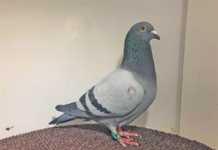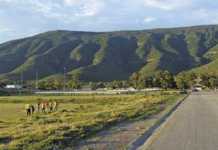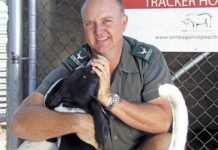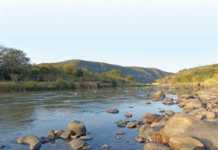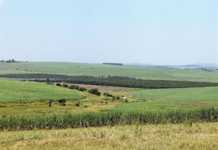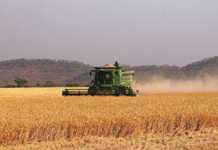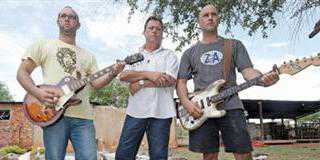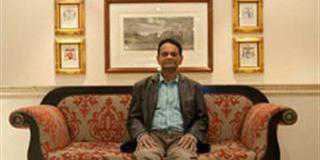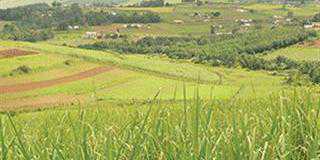Day 2
My orbital line lay to the south, nearer to Temba. On the R101, which runs parallel the N1, I stopped to speak to an old man who makes excellent wooden tractors. I passed the pink apparition of the Carousel Casino. I aimed to go west towards Tswaing, but end up at the Morula Sun, in the shadow of the futuristic and menacing Odi stadium.
I turned and headed back to Winterveld, and then went west, skirting the Winterveld cemetery, into the most aggressive traffic I have ever encountered. Cars were pulling out into the main flow willy-nilly, forcing me over onto the shoulder of red earth again and again. I tacked left, tacked right, and passed a sewerage works, a wedding, and some kind of ceremony where the men all wore khaki and danced in a circle, raising dust.
I made Brits and travelled north to the sizeable Roodekopjes Dam, passing Erdwurms te koop signs. Took lunch at the Beestkraal rail station, where men were drinking bottled beer by a yellow Jeep Rubicon. There was a Kampvuur Fees on the go at a lodge across the road, sponsored by Castle Lager.
A little way on, I swung left into country divided between ranches and platinum mines. Crossed the R522 and tentatively entered a granite quarry, to photograph the drilling grooves in the 30t blocks of gneiss by the side of the road. A male baboon crossed the road and disappeared. Dynamite boomed in the distance. I went left down a mining utility road to Bospoort Dam.
A family had set up camp below the parking area at the corner of the dam wall under a green shade cloth with their rods in the brown water. A young girl was swimming. Look at the rocks, I murmured, look at the rocks… which were stained chlorine-white from the high level mark down to the lapping brown waters. Returning to the car, I was attacked by two Daschunds, their needle teeth snapping at my ankles. “They must defend their owners,” shouted the male of the family.
On the way out a young security guard in military fatigues approached from a storage area for mining equipment. He stood by the window while I talked on the phone. He was wearing a pistol but walked away. I had the strange sense, on the eastern side of the metropole, of somehow being further away from home than I had felt on the west.
There were more worship circles in the veld, more veld, bigger conference venues and dirtier dams. Men and women were bundling straw on the side of the R510 to Rustenburg. Local price: 30c/bundle; city price: R3. In places the road, or some mine, has sliced a koppie in half, but otherwise it’s almost possible to imagine I’m in the Matopos, those ineffable hills.
I hit the outskirts of Rustenburg and see the first accident of my trip – the bonnet of a Mercedes crumpled in, the rear bumper of a 4×4 hanging loose from the chassis.
Finally here are mountains, and the fact of their being the only mountains within a hundred kilometres of the city comes across in the jostle of signs and the hyperbole of gate markers: giant urns, granite dolmens, kayaks stuck to billboards, tyres from outlandish construction vehicles painted white and submerged partially in the soil.
In the town of Olifantsnek on the shores of the dam of the same name I bogged down trying to take a pretty picture, a travel magazine-type picture, incorporating water, mountains, a yacht. Failure again.
The R30 swept me away from the mountains and the alliterative Vulture’s Valley conservancy. In Derby I dragged the car off the road and was delighted to find, right where the R509 crosses under the R30, the sensibly named Quicksales Supermarket. The interior put me in mind of Henri Rousseau’s jungle scenes, such was owner Farid’s genius for colour.
The red-and-white tiled floor space had been divided up into a delta by islands of colourful produce propped on red crates. Four green-fingered garden rakes had been placed by the eggs, their purpose, I am sure being to echo the nearby column of green Cresta Rice packets. Large beach umbrellas weren’t neatly rolled but open all over the place, and stacks of 20-year-old paper bags with rubber handles were strung up with hairy string at each aisle end.
Farid, neatly bearded with young eyes, was overjoyed to hear my praise. “I love greenery,” he said, “you should see my garden.” He’s lived in Derby for 52 years. “I enjoy the gamadoelas. Everything I like is out here: open space, the dams – I love fishing.”
His married sons were visiting but he didn’t think they would take over the business. “They need to walk their own path through the world. It’s dangerous to interfere beyond a certain point,” he said. All the time I was clicking away. I increased the aperture value in an attempt to let the colour flow into this strange new device, but in my shaky hands the Casbah scene blurred again and again. I made a pile out of some square packages and tried to steady the camera that way, only realizing afterwards that I had been interfering with value-pack tampons.
Outside, the sun was freefalling into a bank of purple cumulonimbus. After Farid the landscape was refreshed, I had a renewed sense of bounty. I passed long fields of flowering canola, towering maize rows, sunflowers alert to the coming rain. In Welverdiend flat grassy verges went seamlessly through wire property fences to flat green gardens in which bearded men sat drinking by smoking fires. I followed the railway line away from Carletonville and turned to see a straw-hatted man in blue overalls aligned with both the setting sun and a long arch of a centre-pivot irrigation structure, and its spindrift was a shroud of rainbow colours.
When I arrived at The Ferryhouse Cocktail Bar on the bank of the Vaal in Parys the owner Ryno told me that RL, who agreed earlier on a whim to drive out of the city and meet me, had just left to book us a campsite at Mimosa Park down the road. An earlier SMS from RL read: This place [the bar] is a national treasure, drive fast. It is. I tried to think of other South African bars that overhang pretty rivers (and the Vaal at this point is a pretty river, split by willowed islands and flowing well, the colour of milky coffee). There aren’t many.
It was warm and candle holders made gothic by months of dripping wax were being lit by a waitress with alabaster legs, wearing tiny black shorts. I asked for a straw for my cocktail. “No straws, I’m afraid,” she told me in a cute Afrikaans lisp. “The ou drollies in the retirement complex next door complain the paper bits blow into the river and wash up on their beach.” RL arrived, already in love with Juanita the waitress, who he insisted on calling Jocinda. He could not believe he had never been to Parys before, but then we counted off the various nastier aspects of the Vaal triangle: sewerage spills, mining headgears, right wing factions, chemical sunsets, highway murders. Many of these elements are sadly still at large.
Day 3
This was taken up accompanying the erudite and entertaining Graeme Addison on a very enjoyable tour of the Vredefort Dome, where a meteorite the size of Table Mountain struck some 2000 million years ago. It’s an expedition I’ve described in a previous blog.
Day 4
I complete the south-eastern section of my ‘orbit’ with my mother. A flagrant environmental disregard emanates from Sasolburg to taint the whole area. Huge concrete chimneys belch white smoke, which leans across the sky away from the wind. Steel enmeshes square concrete blocks. Our eyes started watering, and not out of sympathy for the birds.
We skirted around Vaal Park, and when the tar ended in a riot of blackjacks, a cyclist emerging from the weed patch said: “This is the end.” We turned around and passed empty watchtowers as the sun lined the dark clouds with a dazzling white thread, then we headed east through a township before turning onto a single track farm road signed S42.
We bumped along this for half an hour or more, and gradually the stacks receded and disappeared. When we finally made tarmac, we were right by the Vaal Dam. I had never seen it before, and was surprised to find it suddenly on both sides of the R716.
The sun was low, but bright, and the haze and the shadow transformed the water into splurges of Palaeozoic blue set in a landscape filled out with Cenozoic reds and tans. Then the sun turned everything into a gnat-hung scene of yellow and silver.
Oranjeville was quiet at dusk. A rough-looking man left a bar and walked to his bakkie. The Vaal Dam curled around the town like a kidney bean. Only from a map do you see that the various expanses of water, some near and some far, are all one. We came to a long and disconcertingly low single track bridge over stormy brown waters, hearing the water slap against the concrete supports of what was obviously supposed to have been a second bridge for oncoming traffic.
On the far side a woman with a blanket over her shoulders was chanting at the roiling waves. “Goodness,” said my mother, and we carried on east.
With photography on my mind I slowed down several times, especially when I thought I might be able to get a windmill between me and the burst bag of red sun along the horizon. I stopped by a giant rectangular hay bale, and again by a forest near the Jim Fouché resort. All the photographs I took were terrible. It was dark by the time we reached Villiers and the highway home.

